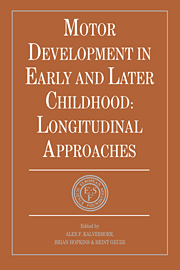Book contents
- Frontmatter
- Contents
- List of contributors
- Foreword
- Preface
- SETTING THE SCENE
- SECTION I BIOLOGICAL BASIS OF MOTOR DEVELOPMENT
- SECTION II DEVELOPMENT OF BODY POSTURE AND GOAL-DIRECTED REACHING
- 6 Early postnatal development of posture control: normal and abnormal aspects
- 7 Studying the development of goal-directed behaviour
- 8 Development of motor functions: a ‘developmental neurological’ approach
- SECTION III MOTOR DEVELOPMENT, EARLY COMMUNICATION AND COGNITION
- SECTION IV ACQUISITION OF SKILLS
- SECTION V MOTOR DEVELOPMENT AND HANDICAP
- SECTION VI METHODOLOGICAL AND CONCEPTUAL CONSIDERATIONS
- Epilogue: description versus explanation
- Index
7 - Studying the development of goal-directed behaviour
from SECTION II - DEVELOPMENT OF BODY POSTURE AND GOAL-DIRECTED REACHING
Published online by Cambridge University Press: 05 May 2010
- Frontmatter
- Contents
- List of contributors
- Foreword
- Preface
- SETTING THE SCENE
- SECTION I BIOLOGICAL BASIS OF MOTOR DEVELOPMENT
- SECTION II DEVELOPMENT OF BODY POSTURE AND GOAL-DIRECTED REACHING
- 6 Early postnatal development of posture control: normal and abnormal aspects
- 7 Studying the development of goal-directed behaviour
- 8 Development of motor functions: a ‘developmental neurological’ approach
- SECTION III MOTOR DEVELOPMENT, EARLY COMMUNICATION AND COGNITION
- SECTION IV ACQUISITION OF SKILLS
- SECTION V MOTOR DEVELOPMENT AND HANDICAP
- SECTION VI METHODOLOGICAL AND CONCEPTUAL CONSIDERATIONS
- Epilogue: description versus explanation
- Index
Summary
Goal-directed behaviours or actions are purposeful. They serve specific functions for the performer. This does not mean that such behaviours always attain the goal for which they aim or that they attain the goal equally well. It is the intentions that make behaviours into actions not the efficiency of the operations themselves. Intention, as we often use the term has also a connotation of choice in terms of when to initiate an action and what action to initiate. This is not how the term is used here. Some actions may very well be initiated by specific stimuli at specific states of the organism. Such movements are still actions as defined here if they are organized in terms of means-end and prospectiveness. I like to argue that all movements produced by animals are of this sort, with only a few rare exceptions. The crucial argument for this comes from biology.
The successful solution of action problems in evolution is always a question of both developing, or getting access to, the right tool for the action and controlling the tool to achieve the goal of the action (Arbib, 1981). Controlling the tool requires an adequate neural mechanism or network and also adequate information to drive the system. The design of the body of any animal, its perceptual system, its motor system and indeed its nervous system have been tailored to each other for optimal functioning by natural selection. The wings of a bird are essential for flying, but, without the proper neural mechanism for driving them and the proper perceptual system for controlling them, they are useless.
- Type
- Chapter
- Information
- Motor Development in Early and Later ChildhoodLongitudinal Approaches, pp. 109 - 124Publisher: Cambridge University PressPrint publication year: 1993
- 4
- Cited by



